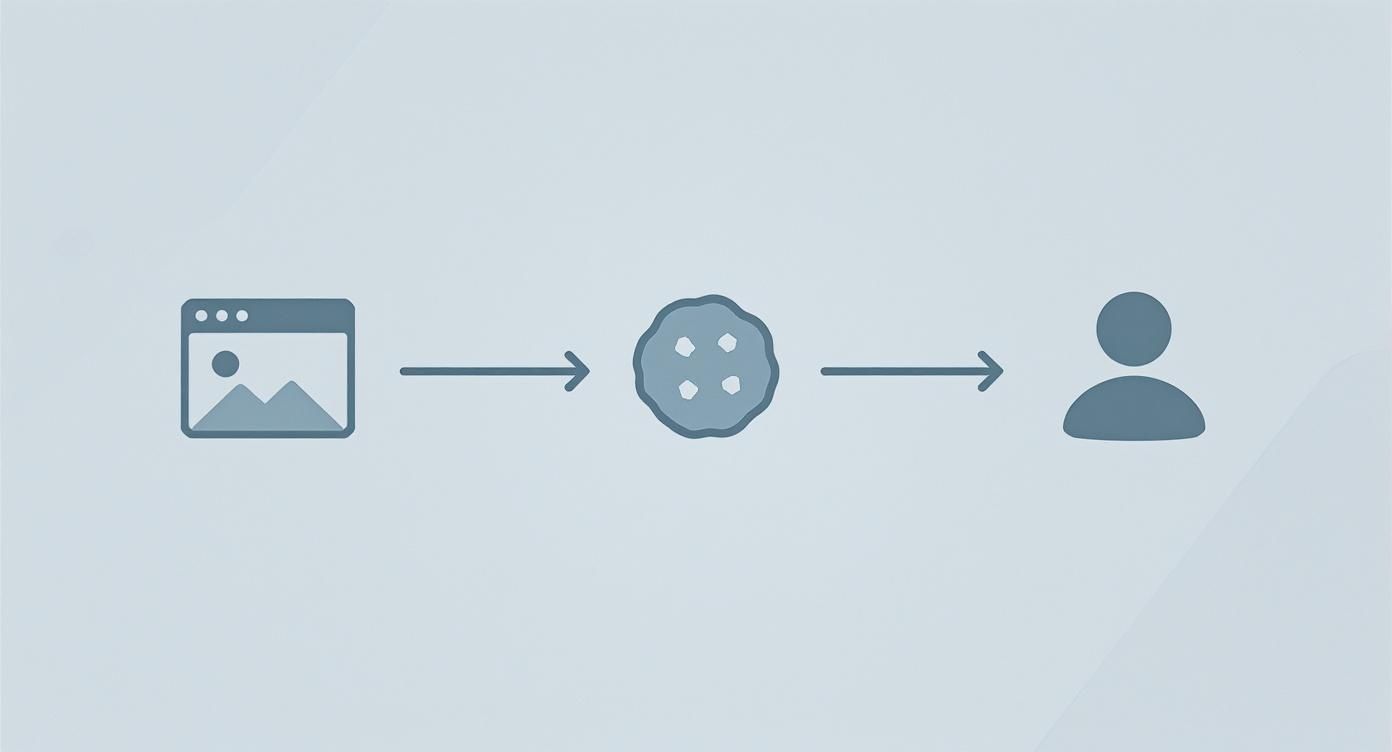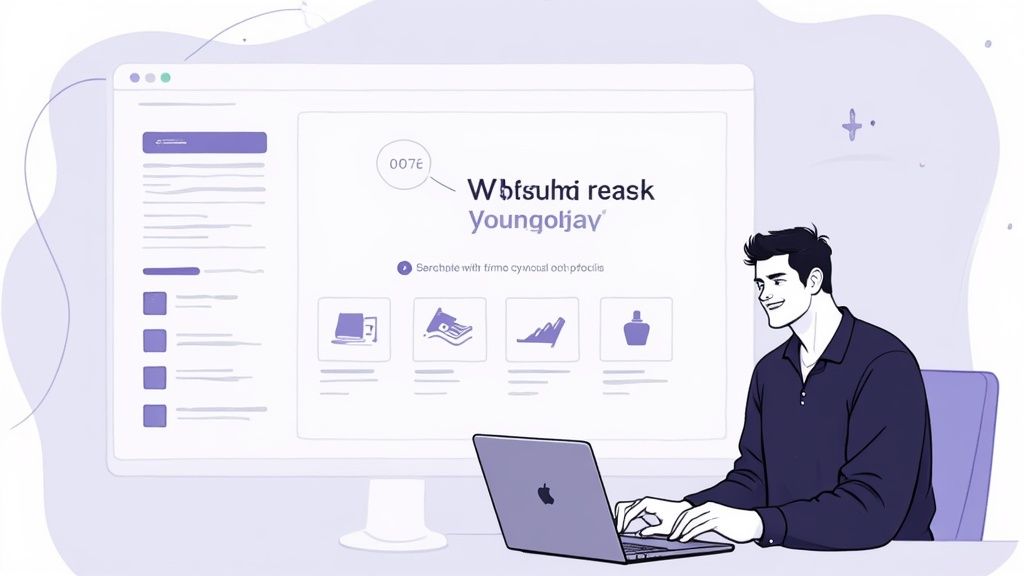- Date
A Guide to the 1st Party Cookies
 Andrii Romasiun
Andrii Romasiun
Let's get straight to it: a 1st party cookie is a little text file created and placed on your computer by the website you're actually visiting.
Think of it like a barista at your favorite coffee shop who remembers your usual order. That's what a 1st party cookie does—it helps the website remember you, your login info, and your preferences to make your visit smoother and more personal.
Why 1st Party Cookies Matter Now More Than Ever

The internet is going through a massive privacy-focused shift, and 1st party cookies are right at the center of it. For a long time, the digital world ran on third-party cookies—those trackers placed by other domains that followed you from site to site. That era is quickly coming to a close.
All the major browsers are pulling the plug on these cross-site trackers, which means website owners have to get back to basics: building direct relationships with their audiences. This isn't just a small tech update; it's a huge move toward a more transparent web built on trust. With Google Chrome, which dominates with 64% of the global market, set to phase out third-party cookies into 2025, this isn't a trend—it's the new reality. You can find more great insights into this shift in the cookie-free marketing landscape.
This industry-wide pivot puts first-party data, collected with consent through 1st party cookies, right back where it belongs: as the gold standard for understanding what people actually do on your site.
The Foundation of a Good User Experience
At their core, 1st party cookies are simply what make a website work the way you expect it to. They're behind all the little conveniences we take for granted.
Here’s what they handle:
- Remembering your login details so you don't have to re-enter them every single time.
- Keeping items in your shopping cart while you continue to browse the store.
- Saving your preferences, like your preferred language, region, or display settings.
Imagine a world without them: every visit to a site would be like starting from scratch. All that helpful context and convenience would be gone. This direct relationship between the user and the website is precisely why they're seen as trustworthy and absolutely essential.
Understanding How 1st Party Cookies Work
Let's break down what a 1st party cookie really is. At its simplest, it's just a tiny text file that a website you're visiting places in your browser. Think of it like a digital nametag that only that specific website can create and read. This direct, one-to-one relationship is what makes it tick.
The main reason these cookies exist is to make your life easier. They're the magic behind an e-commerce site remembering what's in your shopping cart as you browse. Without them, your cart would reset every time you clicked on a new product—a truly frustrating experience.
The Mechanics of Memory
This "digital memory" handles a lot of the background work we now take for granted. Every time you revisit a site, its 1st party cookie helps it recall key details about you, making your visit feel connected and smooth.
This memory is used for a few key things:
- Session Management: This is what keeps you logged in as you navigate through different pages of your account.
- Personalization: It remembers your preferences, like your chosen language, location, or currency settings.
- User Analytics: It helps the site owner understand how people are actually using their website—which pages are popular, how long people stick around, and so on.
Think of a 1st party cookie as the website's short-term memory of your visit. It’s what stops every click from feeling like you're starting from scratch, creating a much more intuitive journey.
What’s crucial here is that this whole process is self-contained. The website you're on creates the cookie, and that same website is the only one that can access it. This contained interaction is why 1st party cookies are a fundamental and widely accepted part of how the web works today.
If you want to get into the weeds on the technical side, you can explore our guide covering everything you need to know about cookies.
1st Party vs. 3rd Party Cookies: What's the Real Difference?
To really get why 1st party cookies are so important, it helps to see them next to their more notorious cousin, the third-party cookie. The whole difference boils down to one thing: relationships.
Think of a first-party cookie like the friendly barista at your local coffee shop who remembers your usual order. It's a direct, helpful interaction with the business you've chosen to visit, making your experience smoother. It remembers your login, what’s in your cart, or your language preference—all things that make that specific site work better for you.
A third-party cookie, on the other hand, is like a stranger you've never met following you from shop to shop, jotting down notes on everything you look at. Their goal isn't to improve your experience in any one store; it's to build a profile on you to sell you stuff later, no matter where you go online. This core difference in who creates them and why is the reason browsers are cracking down.
This infographic breaks down the simple, direct relationship of a first-party cookie.

As you can see, it’s a self-contained loop. The website you're visiting creates a cookie to recognize your browser, and the information stays between the two of you.
A Quick Comparison
While the underlying technology is similar, their purpose and how they're treated couldn't be more different. Here's a quick table to make the distinctions crystal clear.
1st Party vs 3rd Party Cookies A Quick Comparison
| Attribute | 1st Party Cookie | 3rd Party Cookie |
|---|---|---|
| Created By | The website you are actively visiting (e.g., yoursite.com). | A different domain than the one you're on (e.g., an ad network). |
| Data Access | Only the website that created it can read the data. | Can be accessed by any website loading the third-party server's code. |
| Primary Purpose | To improve user experience on a single site (logins, cart, preferences). | Cross-site tracking, ad retargeting, and building user profiles. |
| Browser Support | Universally accepted and supported by all browsers. | Blocked by default in Safari and Firefox; being phased out in Chrome. |
The takeaway is simple. One cookie is built to serve your immediate needs on a site, while the other is designed to serve advertisers, often without your explicit knowledge and at the expense of your privacy.
This is exactly why the 1st party cookie has become the cornerstone of a more privacy-conscious web. It provides the functionality we need without the invasive tracking we don't, making it the clear path forward as third-party cookies fade into the past.
The Role of 1st Party Cookies in Modern Marketing

As the advertising world pivots hard toward user privacy, the humble 1st party cookie has stepped into the spotlight. Once just a simple piece of tech, it’s now the cornerstone of modern marketing. These cookies are how you build real, direct relationships with your customers, using data you collect yourself, with their permission.
This isn't a small change; it’s a fundamental shift. We're moving away from "renting" audiences through third-party data and toward "owning" the relationship with our users. The focus is no longer on tracking people across the entire web but on making their experience on your site as good as it can be. That’s where first-party data really shines.
With third-party cookies on their way out, some of the biggest brands in the world are scrambling to build out their own data strategies. Companies like Disney, McDonald’s, and The New York Times are investing millions in systems that foster direct consumer relationships. They know that first-party data is the key to effective targeting and personalization from here on out.
Powering Personalization and Analytics
The real magic of a 1st party cookie is in what it lets you do right away. You can create those tailored experiences that make people feel understood, something that’s nearly impossible with generic, third-party data.
Think about these simple but powerful examples:
- Greeting a returning user by name once they've logged in. It’s a small touch, but it makes the experience personal.
- Recommending products based on what they've already browsed or put in their cart on your site.
- Saving a user's progress if they’re filling out a long form or taking an online course, making it easy for them to pick up where they left off.
A solid first-party data strategy isn't just a "nice-to-have" anymore—it's a real competitive edge. You get to understand how your audience behaves on your terms, without handing those insights over to external ad networks.
On top of that, these cookies are absolutely essential for accurate, privacy-first analytics. They let you see exactly how people move through your website, which content is a hit, and where they might be getting stuck. This direct view gives you clear, actionable information to make smarter business decisions and build a more reliable path to growth.
Navigating Privacy and Security Responsibilities
Just because a 1st party cookie is a better, more trusted tool doesn't mean it’s a free-for-all. Using them comes with some serious ethical and security responsibilities. Regulations like GDPR and CCPA still apply, and you absolutely need clear user consent for anything that isn't strictly essential for your website to function.
This all comes down to being transparent. If you're using a first-party cookie for analytics or to personalize someone's experience, you have to tell them what you're doing and get their explicit opt-in. This is how you build trust, which is quickly becoming the most valuable currency online. For a clear example of this in practice, you can review our own straightforward cookie policy.
Protecting First-Party Data
Beyond getting consent, you have a critical duty to secure the data you collect. The information stored in a first-party cookie, like a session ID, is a prime target for cyberattacks. If you don't protect it properly, you're leaving the door open for things like session hijacking.
User trust is the ultimate goal. A responsible first-party data strategy is built on transparency and a genuine commitment to protecting customer information, not just finding a loophole to track them.
This is an area where, shockingly, a lot of websites drop the ball. Research shows that only about 26% of websites properly secure their session cookies, leaving the vast majority of users vulnerable. This really drives home a key point: a 1st party cookie might be better for privacy, but its security is entirely in your hands. You can discover more insights about cookie security statistics to see just how widespread the problem is.
Ultimately, your responsibility is twofold: respect user privacy by getting clear consent, and actively protect the data they entrust you with. Getting both of these right is non-negotiable for building a sustainable, trustworthy presence online.
What's Next? Building Your Marketing on a First-Party Foundation
The shift away from third-party tracking isn't the end of digital marketing; it's the start of something better. It’s a chance to build your strategies on a solid foundation of trust and direct relationships, rather than chasing strangers across the internet.
The future belongs to companies that earn, not take, their audience's attention. This is where 1st party cookies and the data they collect shine. When you gather information ethically and transparently, you're not just collecting data—you're building a relationship. It's a simple value exchange: users share information because you give them a better, more relevant experience. That's how you create real, lasting loyalty.
Think of this as an opportunity to build a more resilient and effective marketing engine. When you put privacy first and deliver genuine value, you're not just adapting—you're creating a sustainable strategy for growth.
For businesses that want total control over their data, a great next step is implementing a self-hosted web analytics solution. This move guarantees you own every bit of your data. By focusing on direct insights from your own audience, you build a powerful competitive advantage that also respects user privacy. This isn't just about ticking a compliance box; it's about building a smarter, more trustworthy business.
Your Questions About 1st Party Cookies, Answered
Let's cut through the confusion. The world of web cookies can feel a bit murky, so I've put together some quick, straightforward answers to the questions I hear most often. This should help clear things up.
Are 1st Party Cookies Going Away Too?
Nope, don't worry. 1st party cookies aren't on the chopping block. They’re the good guys, essential for making websites work the way we expect them to.
When you hear about the "cookie apocalypse," that's all about third-party cookies. Browsers like Chrome, Safari, and Firefox are ditching them because of major privacy issues, but 1st party cookies are sticking around.
Can Users Block 1st Party Cookies?
Absolutely. Anyone can go into their browser settings and block all cookies, including those from the site they're visiting. It’s their data, their choice.
But here’s the catch: doing so often breaks the website. Things like staying logged in, keeping items in your shopping cart, or saving your language preferences will suddenly stop working.
For the most part, websites simply can't function properly without first-party cookies. That's why they are widely accepted as a necessary part of a smooth online experience.
Is a 1st Party Cookie Considered PII?
On its own, a 1st party cookie isn't usually considered Personally Identifiable Information (PII). Think of it as an anonymous ticket stub—a random string of characters like ID=8b3a9c1f.
However, the moment you log in or fill out a form, the website might connect that anonymous ID to the personal details you just shared (like your name or email). At that point, the data linked to the cookie absolutely becomes PII and is protected by privacy laws like GDPR.
How Long Does a 1st Party Cookie Last?
That’s entirely up to the website that sets it. There are two main flavors:
- Session Cookies: These are temporary. They disappear the second you close your browser tab or window.
- Persistent Cookies: These hang around for a while. A website might set one to last for a few days, months, or even years to remember your settings for your next visit.
Ready to harness your first-party data without compromising user privacy? Swetrix provides clear, actionable insights with a cookie-free, privacy-first approach. Start your 14-day free trial today and see what you've been missing.